Organisational culture refers to the values and behaviours that contribute to the unique social and psychological environment of organisations. Organisational culture starts at the very top with leadership teams who develop a set of attitudes, behaviours, and expectations in the workplace. Leadership styles aren’t the only element involved, however. The objectives, missions, and values of a company also need to be taken into consideration.
It is through these characteristics that company culture is born. It’s what makes one competitor different from the next. And in some cases, it’s what keeps one company afloat while others sink.
Reading
Read this blog to give you an idea of how organisational culture operates.
It addresses the following:
- What is organisational culture?
- Why does organisational culture matter?
- What are the benefits of a great work culture?
- The signs of a toxic work culture, and
- Ways to enhance workplace culture.
When companies are looking for new employees – they may not be looking for specific skills, knowledge, or education. Instead, they are looking for employees who are well-aligned with the company values. If employees are aligned with the company’s values, they can be taught the skills and knowledge required to perform their roles.
HRM plays a pivotal role in the company culture; they are often the first point of contact for a potential new employee and will set the tone of the company culture. This continues as the employee progresses through their career with the company.
We will use the New Zealand School of Tourism as an example. The values of this company are well known to all staff, but more than just knowing that values exist, staff demonstrate the values daily. How a value is demonstrated/seen in action is called a norm. As an organisation, they not only hire staff based on their skills and experience, but they also focus on that person’s alignment with them as an organisation.
The NZST Company Values
This table contains the NZST company values that directly contribute to the culture of your class in the online space.
 |
Act Positively The solution-focused motor that drives us, ensuring that the glass is always 'half-full'. |
 |
Drive Innovation Running with change to continuously define why we are the industry leaders. |
 |
Pursue Excellence Evolving and adapting what we do to turn great into outstanding. |
 |
Have Fun The way we express our enjoyment for who we are and what we do - it is the icing on the cake. |
 |
Demonstrate Integrity The ultimate measure of our reputation for doing the right thing. |
 |
Develop People The most important investment we make is who we are and our reason for being. |
Reflection
How you demonstrate these values daily is the norm. Think about what is needed to foster a safe and supportive environment for study.
Examples of class values are:
- Have pride
- Show respect
- Have fun
- Be honest
- Act positively
- Be friendly.
Learning Activity: Class Values
What would happen if students were not aligned to the class values or if there were no class values?
Name six consequences that might occur.
Post your response in the Forum, Class Values.
Reflection
Here is a comprehensive word cloud that illustrates the positive aspects of a supportive working environment. Review the words. Consider if any other words need to be included here.

This section contains specific case studies that profile different companies and their approach to their operating environment and their organisational culture. Some of them have learning activities attached.
Case Study 1: AJ Hackett
Read the following section from the AJ Hackett company profile.
AJ Hackett Bungy New Zealand is an iconic New Zealand tourism brand. From the early beginning with the first commercial Bungy Jump operation in 1988, AJ Hackett Bungy New Zealand today owns and operates a diverse range of tourism products in Queenstown and Auckland.
AJ Hackett Bungy New Zealand prides itself on being a world leader in challenge and adventure, to maintain this position we will continue to exceed others’ expectations.
AJ Hackett Bungy, "The Bungy Originals", is a sustainable tourism operation representing adventure through Bungy jumping as a core activity, life experience, self-development, and innovation through complementary adventure-based activities. Recognised as experts in fun and adventure, the business culture is one of safety, innovation, humour, and respect.
The AJ Hackett Bungy New Zealand sites are places of personal challenge, achievement excitement, "Kiwiana", and entertainment. AJ Hackett Bungy NZ is one of the largest employers in Queenstown and has an admired and envied company culture. It represents the town’s character – adventure, fun, innovative, challenging, and here to stay.
Bungy Jumping has become, because of AJ Hackett Bungy, a Kiwi icon and exemplifies all things "Kiwi".
As a company, it is constantly growing, evolving, and polarising and is full of characters and stories.

Learning Activity: AJ Hackett
Write a short paragraph describing the culture at AJ Hackett.
Post your responses to the Forum, AJ Hackett, and share your work with your online peers.
Corporate culture is often blamed for massive business failures and given credit for huge successes. Duke University talked to nearly 2,000 executives to learn their views on corporate culture. They used this information to discern whether culture deserves all this credit and blame. Their research project provides a framework that helps us to explore what corporate culture is, what parts of a company culture affect and how, and what a company should do to improve its culture.
Watch the following video
It is based on corporate culture and is made by Duke University. (14:34)
Important
Two quotes from the research discussed in the video are very interesting. These are:
- ‘Culture allows you to execute. Culture is like the tendons and ligaments that hold the body together and allow it to be healthy as a body and execute daily.’
- ‘Culture is your sheet music to success. It is no different than an orchestra. You can hire the best trumpet players, oboists, and violinists, and you will fail unless they are all playing from the same sheet of music at the right tempo. If the trumpets are playing too loud, the song won’t sound right. It is that delicate balance of getting people on the same page.’
The actions influenced by corporate culture include the following:
- Investment risk – too much or too little risk as a culture is not right. Effective culture will take an appropriate level of risk to support a healthy culture of growth
- Ethics – if the culture is not right will lead to unethical or illegal practices
- Short-term vs. long-term – there are bad outcomes that focus too much on the short term. An effective culture focuses more on long-term outcomes
- Mergers and acquisitions – the target company is aligned on the operational side, but if the culture is misaligned, most companies would not pursue it.
Corporate culture can be improved by the following:
- Leaders must define and live corporate values, and encourage employees to live values day to day. It needs employees at all levels to buy into it
- The company must invest in culture, and use dedicated time and resources to instil and reinforce culture. Recognise, celebrate, and even promote employees who live the culture
- Continuous, long-term commitment which happens week after week, never ends.
An organisation with an ineffective culture or no culture would suffer from:
- No sense of belonging/community
- Everyone will be doing the same thing as there is no awareness of their fit in the organisation and how they benefit the company
- No accountability for not being aligned with values
- Reduced motivation and loyalty
- High levels of absenteeism
- There is also a higher rate of turnover at an organisation with poor company culture
- Conflict in the workplace
- Low in profit.
Values
Your values are what you believe are important in how you live and work.
They (should) determine your priorities, and deep down, they're probably the measures you use to tell if your life is turning out the way you want it to.
When the things that you do and the way you behave match your values, life is usually good – you're satisfied and content. But when these don't align with your values, that's when things feel... wrong. This can be a real source of unhappiness. Values are usually stable, yet they don't have strict limits or boundaries. Also, as you move through life, your values may change.
Source: https://www.mindtools.com/a5eygum/what-are-your-values
Important
Take this Personal Values Assessment to help you discover your core values.
Case Study 2: Amazon

Amazon is one of the world’s biggest retailers, with a market value of over USD$700 billion.
- Using the following website – describe the culture and values of Amazon
- Consider your values. Do you think you would fit in working there? Do your values align with those of Amazon? If not, why not?
Now watch the following video about an Amazon employee. (1:17)
In 2015, a controversial news story broke regarding the culture at Amazon. The following were cited by employees as being indicative of a problematic workplace.
- They were evaluated too harshly
- There were inconsiderate working conditions (do more in less time)
- There were unbearably high standards
- It was the survival of the fittest (if you don’t fit in you are out)
- Medical emergencies not dealt with in appropriate ways
- It was an unsupportive environment (people crying at their desks)
- There was a high turnover of staff
- There was no paid maternity or paternity leave.
Learning Activity: Amazon
Consider the following two questions.
- As a consumer, did these resources above change your perspective on purchasing products from Amazon? Explain why.
- As a potential employee – how did these resources change your perspective of possibly working for Amazon? Explain why.
Share your responses with your peers, and post to the forum, Amazon.
The following image illustrates the visible organisational culture of an organisation, with the invisible organisational culture under the surface. Reflective of the employee's grievances at Amazon.
Case Study 3: Virgin Atlantic

Virgin Atlantic is an iconic brand and receives thousands of job applications yearly. Watch the following HR video for Virgin Atlantic, entitled,” It’s What We Do”. (3:24)
From watching this video, what do you think the culture would be like at Virgin Atlantic?
As we know from the Duke University case study and the Amazon reports, culture must be lived and breathed by every person within the company, especially those in management and senior positions. Virgin Atlantic’s culture is displayed throughout the company, including its leader Sir Richard Branson.
I'm often asked what it is that makes Virgin different. The simple answer is – our people. If it weren't for a bunch of well-trained, motivated, and happy people doing their bit, we'd have never launched a record label, never mind a fleet of 747s.
Sir Richard Branson
Read some more about Virgin Atlantic.
Case Study 4: Accor

Accor was founded in the 1960s by two Frenchmen. Forward in their thinking at the time, they radicalised and paved the way for further motivation, guidance, and development – they built a hotel with a bathroom in each room, imagine that!
These ‘futuristic’ thought processes started Accor values that have evolved over the years. They state that, “Hospitality is built on deep-rooted values. Our success has been built on strong human values. The hospitality of tomorrow is rooted in a unique combination of extraordinary experiences, high-performance solutions, and strong human values. They make our actions meaningful, guide everyday activities, and serve as a shared language. Today, we support the cultural transformation of the Group in the service of a strong ambition that enables all employees to feel valued, to grow, and to innovate in the service of customers”.
Watch the following video and think about the key messages of Accor. (2:25)
The following statements are taken from Accor’s values:
“We’re always looking ahead: We challenge ourselves to reinvent, innovate, and create what’s new and next. We're ambitious for our customers. We make the impossible possible to make their dreams a reality.”
“We place people at the heart of what we do: A value rooted in our company culture is described as a Heartists®. This is a culture of inclusion, care, and acceptance! We value our Talents because they are the greatest strength of our Group. We are proud of our differences. We bring our sincere passion for service and care to everything we do. The goal is to make everyone a proactive agent in their growth and free to act independently so they can inspire and be inspired. Make your profession a passion.”
“We are refined: We obsess over the smallest detail. We have sophisticated tastes while remaining accessible to all.”
“We stand by our commitments: We say what we do and do what we say. We're attentive to the outside world, to other people. We are dedicated and resolute to act for the greater good. We aim to build a momentum of creation and positive value for as many people as possible over the long term.”
The word Heartists© is a registered trademark. That means it legally states that the mark has been registered with the US Patent and Trademark Office (USPTO). Read the following link and find out why it is advantageous to register a trademark.
https://bit.ly/2XsxQkVFor Accor, values are a way to clarify what they value as an organisation and the behaviours they want to encourage to support that. Values are what drive their culture, and they are what ultimately determine whether people are going to ‘fit in’ at Accor.
The Story of the Bernache
The Bernache symbol wasn’t chosen for just any reason.
Turn the card to read more about the Accor logo and the incorporation of the Bernache.
Open a world-your world. Join a tribe in the heart of experiences, scripting new experiences. Open hearts, to connect hearts. Together, we make the world more welcoming, caring and inspiring.The Accor Group
Learning Activity: ACCOR
Answer the following three questions about Accor.
- What are the key messages in the video that enable Accor employees to feel valued, grow, and be able to innovate? In the video, how do certain departments of the hotel link to the key message? What’s their relevance?
- What about Accor’s choice of the Bernache as a symbol? How do you think it fits with the company values?
Post your responses to these questions and share them with your online peers in the Forum, ACCOR.
Organisational structure will vary greatly between organisations. It is dependent on the organisation size, type of business, and governance systems. The position of HRM within an organisation will depend on which organisational structure they use, its size, and the type of organisation.
Each organisation will have the organisational structure that best suits its needs. Each structure will have benefits and drawbacks determining which structure best suits the organisation.
Here are five (5) different organisational structures. Click on each heading to explore more about each one.
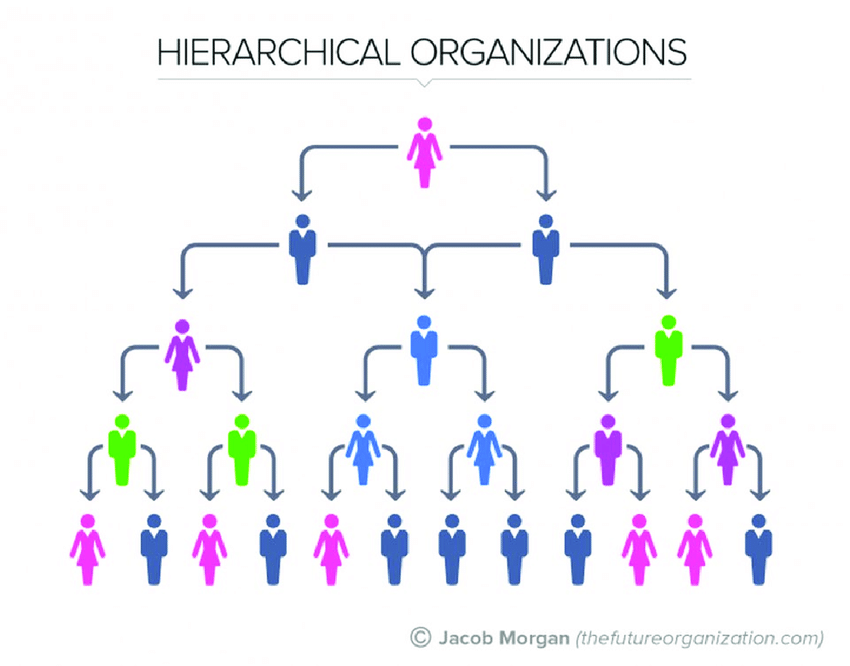
Having a structure consisting of multiple levels. A hierarchical business structure would mean that the chain of command looks like a pyramid, with a large base of workers, who are directly supervised by the smaller level above them, who are in turn supervised by the level above them, continuing to the top-ranking officer such as the company President or CEO. Alternatively, anything that can be broken down into a series of levels that range from broad to specific can be considered hierarchical. (Source: Business Dictionary.com)
Amazon is an example of an organization with a hierarchical structure, largely due to its size. As the largest internet retailer, the company currently employs approximately 560,000 people around the world. With the hierarchical structure, all of Amazon’s employees report to the founder and CEO, Jeff Bezos.
Under Bezos, there are several levels of management across many departments, such as:
- Software development
- Information technology
- Legal operations
- Human resources
- Finance and Administration
- Business operations
- Product management.
The hierarchical organisational structure works for Amazon because the company is organised into several small teams under separate management. This structure allows managers to work more closely with their team members and to facilitate control over their departments.
(Source: https://pingboard.com/blog/hierarchical-vs-flat-organizational-structure-and-benefits-of-each/)
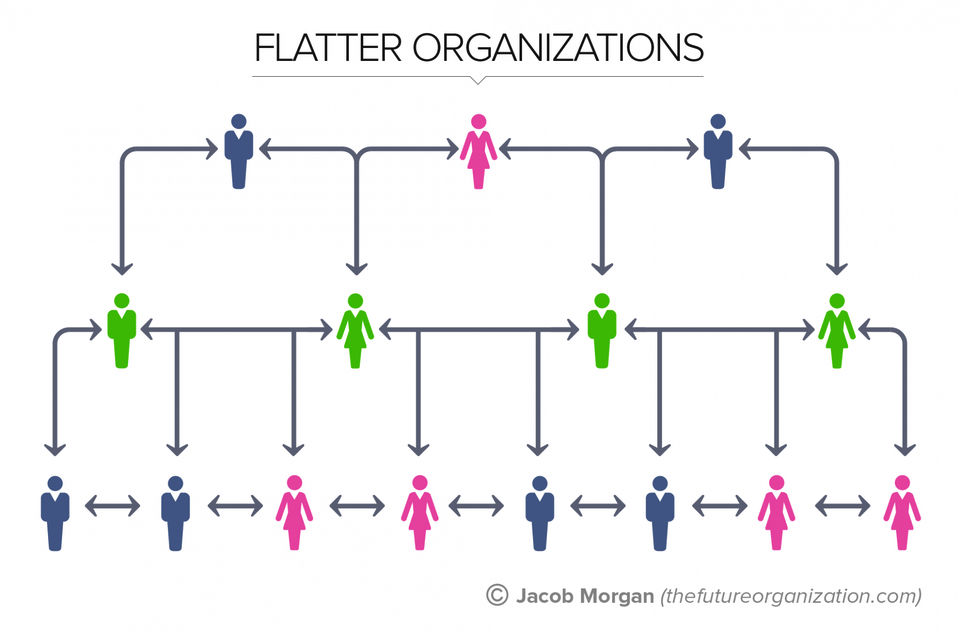
Unlike the traditional hierarchy which typically sees one-way communication and everyone at the top with all the information and power; a "flatter" structure seeks to open the lines of communication and collaboration while removing layers within the organization. As you can see there are fewer layers, and the arrows point both ways.
(Source: Forbes.com)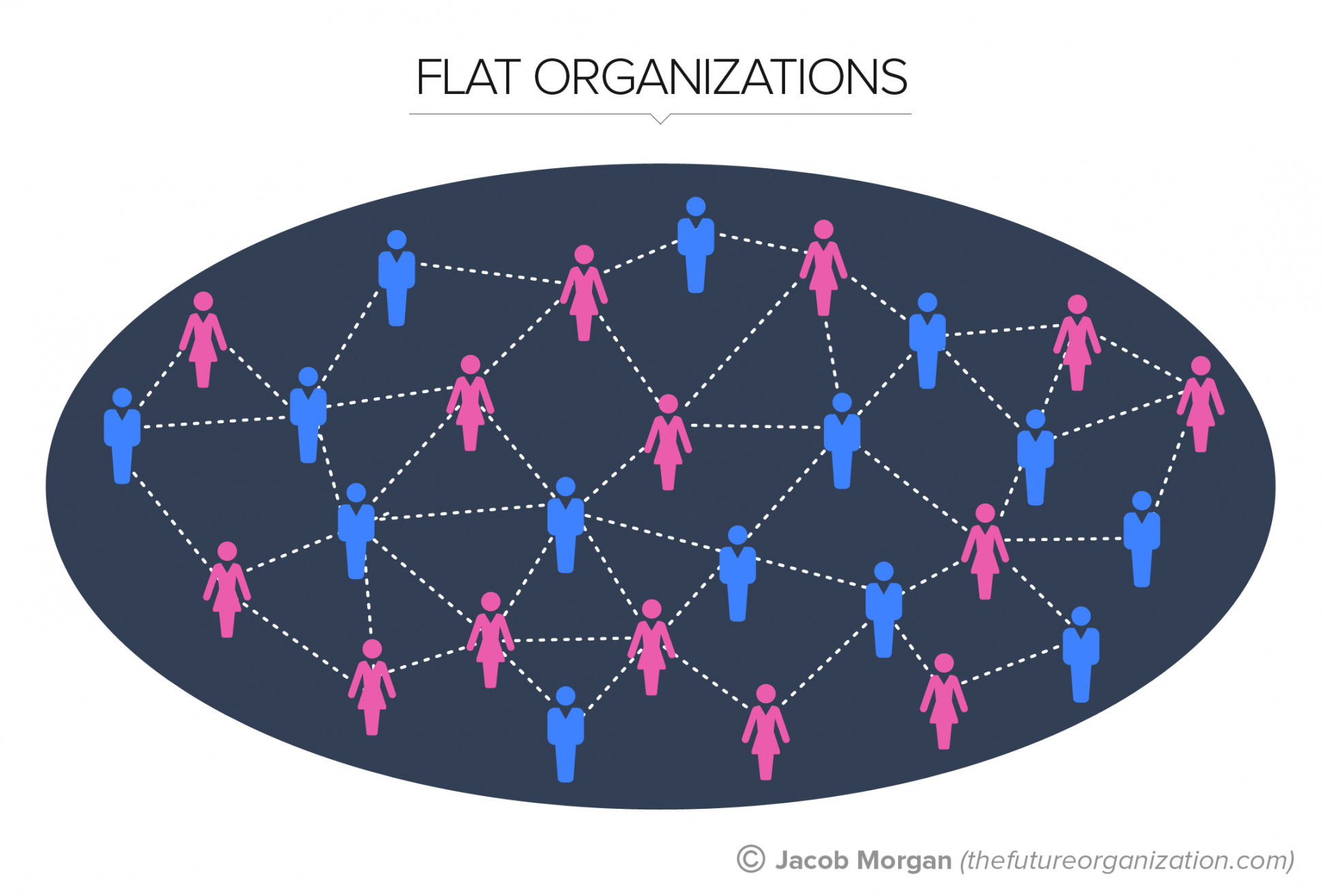
An organisational structure in which most middle-management levels and their functions have been eliminated, thus bringing the top management in direct contact with the frontline salespeople, shop floor employees, and customers. Despite their breadth, flat organisations can benefit from most of the advantages enjoyed by small companies, such as faster response time to changing conditions and customer preferences. (Source: Business Dictionary.com)
Valve’s Flat Organizational Structure
Like many modern organisations, a video game company called Valve has adopted a flat structure for organising employees and clarifying roles and responsibilities. In fact, the gaming startup has placed an increasing emphasis on the decision to go completely boss-less. Although the company does technically have a founder and CEO, Gabe Newell, his role is much more hands-off than that of the average executive.
“Everybody is expected to essentially vote on what is most important to our customers by the projects they work on,” explains Newell. “So, none of them are working on those projects because somebody else told them to work on them. Everybody’s working on those projects because they thought they could make the largest contributions to our customers by working on them. People move around all the time.”
(Source: https://pingboard.com/blog/hierarchical-vs-flat-organizational-structure-and-benefits-of-each/)
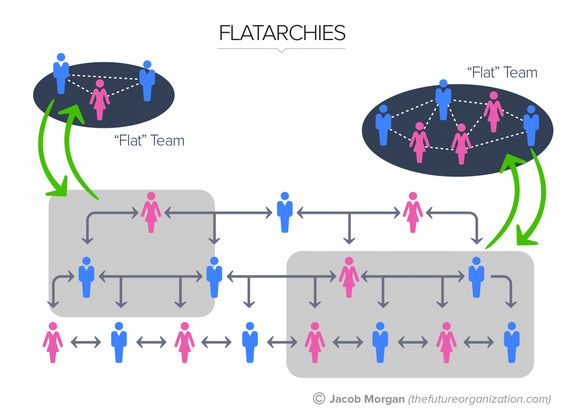
Somewhere in between hierarchies and flat organisations lie ‘flatarchies’. These types of companies are a little bit of both structures. They can be more hierarchical and then have ad-hoc teams for flat structures or they can have flat structures and form ad-hoc teams that are more structured. Flatarchy organisational structure is a structure common with a start-up or small company. It allows employees from different levels to make decisions in the organization. An example of this type of structure is when an organisation has an internal hub or innovation centre.
(Source: Forbes.com)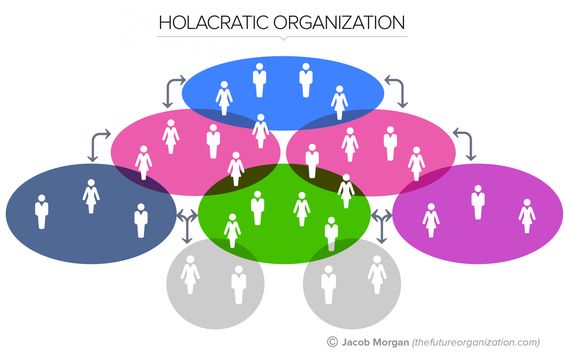
The basic goal of this structure is to allow for distributed decision-making while giving everyone the opportunity to work on what they do best. There is still some form of structure and hierarchy, but it's not based on people as much as it is based on circles or what most people would think of as departments. Information is openly accessible, and issues are processed within the organisation during special and ongoing meetings.
(Source: Forbes.com)
Important
New Zealand is predominantly a nation of small and medium-sized enterprises (SMEs), with 97.2% (463,278) of enterprises in New Zealand employing 19 or fewer people.
In small organisations, the HRM (Human Resource Management) responsibilities may fall within the scope of another position; for example, the manager may be responsible for all the HRM functions, or there may be one HRM position that deals with all HRM functions (often called an HR Generalist). In a larger organisation, there will be a dedicated department for HRM in which specialist HRM positions exist. We will now look at the role of HRM within an organisational structure and use the traditional hierarchal structure.
Small organisations
A small organisation is characterised by less than 50 employees, regardless of revenue, or if the number of employees is unknown, then revenue of less than $5.6m will be taken as an indicator that it is a small business. In this first example, the Manager (or the owner/CEO) will take on all HRM functions.
In the second example, the organisation has a dedicated HRM role, this person looks after all aspects of HRM. You will see this is still a small organisation.
Medium organisations
Between 50 and 249 employees, regardless of revenue, or if the number of employees is unknown, then revenue greater than or equal to $5.6m and less than $22.8m will be taken as an indicator that it is a medium business.
Large organisations
A large organisation is characterised by employees greater than or equal to 250 employees, regardless of revenue, or, if the number of employees is unknown, revenue greater than or equal to $22.8m will be taken as an indicator that it is a large business. (Source: Ministry of Economic Development)
Learning Activity: Organisational Structures
- Think about tourism companies, large and small. Which one would you prefer to work for and why?
- Now that you have a better understanding of organisational structure, what do you think is the purpose of HRM within an organisation?
- What do you think would happen if the company does not have an organisational structure?
Post your responses in the Forum, Organisational Structures.
